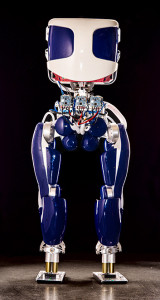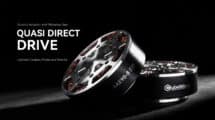SRI Robotics is working on two novel exosuits and new 4D materials that can make it easier to power and operate them. Originally part of Stanford University, SRI International is a nonprofit research institute in Menlo Park, California. The company’s robotic division, SRI Robotics is best known for the development of tele-operated surgery robot later commercialized as da Vinci Surgical System. SRI Robotics is not satisfied with refining already existing technology but instead goes back to basic scientific principles and investigates novel methods and materials.
One way to illustrate how SRI Robotics operates is how the organization approaches the current debate on powering exoskeletons and exosuits: hydraulic, pneumatic, motorized or passive. Each option has its advantages and disadvantages. SRI’s answer is: none of the above! Instead, this research think tank is looking into a fifth, brand new option such as 4D materials and artificial muscles.
For this article, we are defining a 4D material as 3 dimensional object that can change its properties in time. More specifically, SRI International is working on soft layered sheets that can bend and twist, but with applied electric voltage, the sheets are stopped from sliding, producing a rigid structure. The principle is the same as a stack of papers vs a wooden board. Both are made from the same material and the stack of papers will become rigid if they are not allowed to slide against each other. One example from Hollywood movies would be Batman’s cape, which can stiffen to become a hang glider and then relax back into a cape.
Applications of 4D materials for exosuits:
A 4D material could be used as a replacement of the clutch mechanism in the passive ankle exoskeleton by Dr. Greg Sawicki. This could considerably lighten and simplify the exoskeleton or be placed in a more strategic position, at the cost of adding an electrical system. Another fascinating application of 4D materials that SRI Robotics have come up with is for straps and socket fittings. The material can be fitted on a user’s arm or leg while in the soft configuration and then stiffened around the user’s limb. A traditional attachment system can’t be changed once fitted, but these new straps can be relaxed, re-fitted and then instantly re-stiffened to form a new perfect fit.
Other applications for 4D materials include the creation of passive exoskeletons that are soft, but stiffen instantly when under load. This could lead to a new generation of tool holding industrial suits that can be soft while the workers are re-locating from one position to another, but harden and become weight bearing when the tool is in use.
SRI Robotics Artificial Muscles:
Materials that can change their compliance is not the only thing SRI Robotics are working on. The company has also worked on Electroactive Polymer (EAP) which can be used as artificial muscles and sensors that can change their shape. The EAP technology was sold to Parker Hannifin, which describers it as a: “polymer that exhibits a change in size or shape when stimulated by an electric field. The field generates coulomb attractive forces on the electrodes which apply compressive forces on the dielectric causing the change in size or shape. EAP can be used to create a variety of devices including sensors, actuators, and energy harvesting devices.”
Robots and Exosuits:

SRI Robotics already has a vast breath of knowledge in robotic walking and exosuits. The PROXI™ humanoid robot is not an exoskeleton, but a robot with dynamic walking that can walk “up to 20 times more efficiently” than current humanoid robots. This is a really important advancement, especially for able-bodied exoskeletons. Traditional exoskeletons tend to consume a lot of energy during walking, and sometimes even while standing if the motors are used to lock the device in place. In contrast the PROXI™ walks more like a human, and temporarily cuts off power to any motors that are not immediately needed for support. In reality this is much more complicated than it sounds. Furthermore, this humanoid robot is the test bed for more efficient transmission with less friction, low power electrical motors emitting less heat and elastic elements to store energy during the gait cycle. All of these robotic advancements are directly transferable to the SRI exoskeletons.
Finally on the subject of exoskeletons, SRI Robotics has participated in at least two projects: the Super Flex exosuit (feature image) as part of the DARPA Warrior Web project and a pediatric exoskeleton.
As you may be able to guess from reading this article, SRI Robotics had no intention to use existing technology on their exosuit but instead actively tried to push the envelope and included multiple novel features. As a result, there are many different versions of the SRI exosuits. The Super Flex exosuit was developed entirely in-house, but they are different variations of it created in collaboration with Ekso Bionics and Harvard University. The Super Flex exosuit integrates the power saving methods of the PROXI™ and mates them to the human user with a soft exosuit. The prototype for DARPA most closely resembles the exosuits of the Wyss Institute (see: Disruptive: Bio-inspired Wearable Robotics At The Wyss Institute).
The second exosuit in development by SRI Robotics is a soft pediatric exosuit that uses 4D materials for actuation. In principle it is the same as the Magic Arms exoskeleton (see: Videos of Four Passive Exoskeletons) but without all of the bulky 3D printed parts sticking out. The suit is still in very early development, but the initial concept is to have a light flexible 4D material that can change its orientation when energized to provide arm lift. The suit is designed for babies or young children suffering form weak or underdeveloped arm muscles due to neuromuscular disease.
SRI Robotics is a company to watch out for!
SRI Robotics has positioned itself on the frontier of exoskeleton technology. Its researchers are not averse to risk and look for novel approaches to old problems. SRI Robotics regularly collaborates with other exoskeleton groups and has the background knowledge in robotic walking to rival that of Honda. The ExoskeletonReport team promises to keep a close eye on this non-profit research company and report any new information that becomes available to the public!
Find out more about SRI Robotics:
Soft Robots and Changing Form Factors: SRI Blog
ABOUT ELECTROACTIVE POLYMER: Parker Hannifin website
PROXI High-Efficiency Humanoid Robot Platform: SRI website
Superflex Exosuit: stanford.edu










Hello when this robot comes to the market? and how much does it cost?
thank you
Hi, this has spun-off SRI and Superflex is now its own company, see: https://exoskeletonreport.com/2016/04/flexsuit-spin-off-sri-bay-area-becomes-exoskeleton-hub/
The ExR team does not have information on when it will become a product.